‘Richmond’ Category
» posted on Wednesday, March 20th, 2013 by Linda Lou Burton
Serious Business
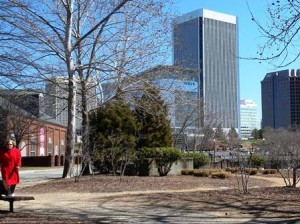 Linda Burton posting from Richmond, Virginia – TD Robinson takes his job seriously. TD is a security guard; he waved me to a stop as I drove riverside along the James. It was the first day of spring and I had the window of the Scion down; enjoying the fresh air and sunshine; waving at the joggers and walkers taking advantage of the footbridges leading to islands in the river. “How are you ma’am?” he asked politely. I realized the road had ended; a large brick building stood to my right. “I think my riverside drive is over,” I laughed. “Where am I?” “You are on private property,” TD replied. I asked what business I had reached, but TD answered only “Private. Property.” Dominion was printed on his badge; I pointed out that fact. With a sideways nod of his head, he offered up this response “You
Linda Burton posting from Richmond, Virginia – TD Robinson takes his job seriously. TD is a security guard; he waved me to a stop as I drove riverside along the James. It was the first day of spring and I had the window of the Scion down; enjoying the fresh air and sunshine; waving at the joggers and walkers taking advantage of the footbridges leading to islands in the river. “How are you ma’am?” he asked politely. I realized the road had ended; a large brick building stood to my right. “I think my riverside drive is over,” I laughed. “Where am I?” “You are on private property,” TD replied. I asked what business I had reached, but TD answered only “Private. Property.” Dominion was printed on his badge; I pointed out that fact. With a sideways nod of his head, he offered up this response “You 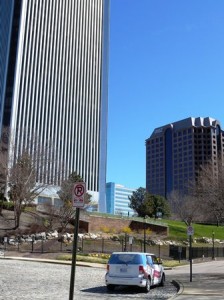 can look, but I can’t tell.” With a sideways nod of my head, I turned the car and headed back towards the city. I was feeling a little testy by now; first I was unable to find parking near the capitol for a spring-day’s walk around the grounds; now my drive along the river was halted. I stopped in the cobblestoned traffic circle on Tredegar to get a few photos for my collection; I wanted to remember where I was on the first day of spring, 2013; then I crossed the river and headed back to my hotel. But I’m thinking all the way – just what businesses are in those tall buildings overlooking the river? Turns out, six Fortune 500 companies are located in Richmond. And Dominion is one of them. » read more
can look, but I can’t tell.” With a sideways nod of my head, I turned the car and headed back towards the city. I was feeling a little testy by now; first I was unable to find parking near the capitol for a spring-day’s walk around the grounds; now my drive along the river was halted. I stopped in the cobblestoned traffic circle on Tredegar to get a few photos for my collection; I wanted to remember where I was on the first day of spring, 2013; then I crossed the river and headed back to my hotel. But I’m thinking all the way – just what businesses are in those tall buildings overlooking the river? Turns out, six Fortune 500 companies are located in Richmond. And Dominion is one of them. » read more
» posted on Friday, March 15th, 2013 by Linda Lou Burton
Sophisticated Simplicity
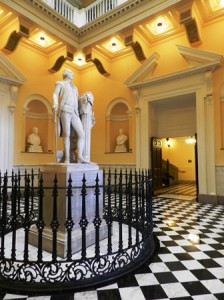 Linda Burton posting from Richmond, Virginia – If you want to know what George Washington really looked like, go to the Virginia state capitol. Centered in the rotunda against the simplicity of a formal backdrop of black and white stands a life-size statue of Washington, considered by his contemporaries to be “a perfect likeness.” It was June 1784 when the Virginia General Assembly commissioned the statue to be made; Thomas Jefferson, on a diplomatic mission in France, secured the services of French artist Jean-Antoine Houdon for the work. Houdon didn’t guess at his task; in the fall of 1785 he traveled to Mount Vernon to study his subject. He made a plaster mask of Washington’s head and took detailed measurements of his body; from this he modeled a terra cotta bust to take back to his workshop in France.
Linda Burton posting from Richmond, Virginia – If you want to know what George Washington really looked like, go to the Virginia state capitol. Centered in the rotunda against the simplicity of a formal backdrop of black and white stands a life-size statue of Washington, considered by his contemporaries to be “a perfect likeness.” It was June 1784 when the Virginia General Assembly commissioned the statue to be made; Thomas Jefferson, on a diplomatic mission in France, secured the services of French artist Jean-Antoine Houdon for the work. Houdon didn’t guess at his task; in the fall of 1785 he traveled to Mount Vernon to study his subject. He made a plaster mask of Washington’s head and took detailed measurements of his body; from this he modeled a terra cotta bust to take back to his workshop in France. 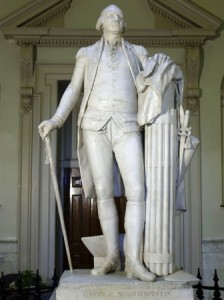 The resulting statue, carved of Carrara marble, was shipped to America in 1796 and has graced the capitol’s rotunda since. It is considered to be Virginia’s greatest treasure and one of the world’s finest portrait sculptures; it is the only full-length statue for which the first President posed. Although Washington’s sword is by his side and he wears his Revolutionary uniform, he
The resulting statue, carved of Carrara marble, was shipped to America in 1796 and has graced the capitol’s rotunda since. It is considered to be Virginia’s greatest treasure and one of the world’s finest portrait sculptures; it is the only full-length statue for which the first President posed. Although Washington’s sword is by his side and he wears his Revolutionary uniform, he 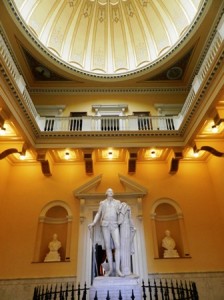 carries a civilian walking cane and stands over a plough; Houdon sought to show the balance between Washington’s life as a soldier, statesman, and private citizen. In the niches of the rotunda are busts of other Virginia-born presidents who succeeded Washington – Jefferson, Madison, Monroe, Harrison, Tyler, Taylor, and Wilson – and another work by Houdon; that of LaFayette, the French citizen who was a Major General in service to the United States during the Revolutionary War. But more about the rotunda itself, a magnificent two-story space capped by a dome; a dome that is invisible from the outside. » read more
carries a civilian walking cane and stands over a plough; Houdon sought to show the balance between Washington’s life as a soldier, statesman, and private citizen. In the niches of the rotunda are busts of other Virginia-born presidents who succeeded Washington – Jefferson, Madison, Monroe, Harrison, Tyler, Taylor, and Wilson – and another work by Houdon; that of LaFayette, the French citizen who was a Major General in service to the United States during the Revolutionary War. But more about the rotunda itself, a magnificent two-story space capped by a dome; a dome that is invisible from the outside. » read more
» posted on Wednesday, March 13th, 2013 by Linda Lou Burton
Right Here In River City
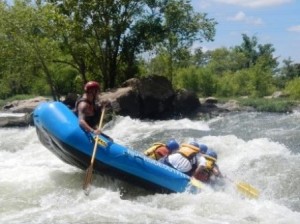 Linda Burton posting from Richmond, Virginia – “The idle brain is the devil’s playground,” goes Meredith Wilson’s song Ya Got Trouble, pointing out the dire things that might happen “right here in River City” if young folks don’t have enough to do. That warning was a highlight of 1957’s Broadway hit, The Music Man, and here in this River City by the James, it has been heeded, because nobody, young or old, has reason to be idle here. Outside magazine last year named Richmond the “Best River City in America,” probably because of the Class IV whitewater the James provides and the 500 acres of parkland that offer outstanding mountain biking and running trails. But when I looked into the “sports and recreation” aspects of this capital city on the river, I found that Richmond residents have a variety of gung-ho goings on to choose from. Biking ranks high, to be sure, and has some
Linda Burton posting from Richmond, Virginia – “The idle brain is the devil’s playground,” goes Meredith Wilson’s song Ya Got Trouble, pointing out the dire things that might happen “right here in River City” if young folks don’t have enough to do. That warning was a highlight of 1957’s Broadway hit, The Music Man, and here in this River City by the James, it has been heeded, because nobody, young or old, has reason to be idle here. Outside magazine last year named Richmond the “Best River City in America,” probably because of the Class IV whitewater the James provides and the 500 acres of parkland that offer outstanding mountain biking and running trails. But when I looked into the “sports and recreation” aspects of this capital city on the river, I found that Richmond residents have a variety of gung-ho goings on to choose from. Biking ranks high, to be sure, and has some 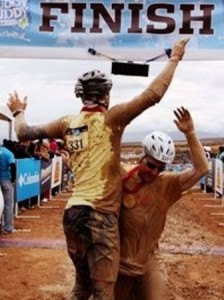 interesting twists, like the Anthem Moonlight Ride under a full moon, in costume; and the Grand Fondo, an all-age, all-fitness ride that covers 100 miles of the Region’s roads. The Muddy Buddy sounds like the most fun; held at Pocahontas State Park in the rainy spring, it’s a 6-mile race for two-person teams on bikes, and on feet; challenging terrain and mud pits make up the obstacle course. There’ll be some serious biking in 2015 as Richmond hosts the World Road Cycling Championship; it hasn’t been held in the USA since 1986, when it took place in Colorado Springs. Planners are busy now with the infrastructure development for this amazing race. As to everything else going on in River City, you’re going to need a long piece of paper to write it all down. » read more
interesting twists, like the Anthem Moonlight Ride under a full moon, in costume; and the Grand Fondo, an all-age, all-fitness ride that covers 100 miles of the Region’s roads. The Muddy Buddy sounds like the most fun; held at Pocahontas State Park in the rainy spring, it’s a 6-mile race for two-person teams on bikes, and on feet; challenging terrain and mud pits make up the obstacle course. There’ll be some serious biking in 2015 as Richmond hosts the World Road Cycling Championship; it hasn’t been held in the USA since 1986, when it took place in Colorado Springs. Planners are busy now with the infrastructure development for this amazing race. As to everything else going on in River City, you’re going to need a long piece of paper to write it all down. » read more
» posted on Monday, March 11th, 2013 by Linda Lou Burton
Few Will Be Grieved
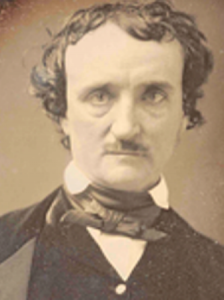 Linda Burton posting from Richmond, Virginia – “Edgar Allan Poe is dead. He died in Baltimore the day before yesterday. This announcement will startle many, but few will be grieved.” Part of a long obituary published in the New York Tribune on October 9, 1849 and signed simply “Ludwig,” this unflattering piece was later published throughout the country. “Ludwig” was revealed as Rufus Griswold, who obviously didn’t like Poe very much; he later wrote a biographical article of Poe and depicted him as a depraved, drunk, drug-addled madman. Edgar Allen Poe (1809-1849) had his enemies and his critics, to be sure; yet today this American author and poet continues to influence literature around the world; his work appears throughout popular culture. He is generally considered the inventor of the detective fiction genre; every year the Mystery Writers of America presents the Edgar Award to someone for distinguished work in the mystery genre.
Linda Burton posting from Richmond, Virginia – “Edgar Allan Poe is dead. He died in Baltimore the day before yesterday. This announcement will startle many, but few will be grieved.” Part of a long obituary published in the New York Tribune on October 9, 1849 and signed simply “Ludwig,” this unflattering piece was later published throughout the country. “Ludwig” was revealed as Rufus Griswold, who obviously didn’t like Poe very much; he later wrote a biographical article of Poe and depicted him as a depraved, drunk, drug-addled madman. Edgar Allen Poe (1809-1849) had his enemies and his critics, to be sure; yet today this American author and poet continues to influence literature around the world; his work appears throughout popular culture. He is generally considered the inventor of the detective fiction genre; every year the Mystery Writers of America presents the Edgar Award to someone for distinguished work in the mystery genre. 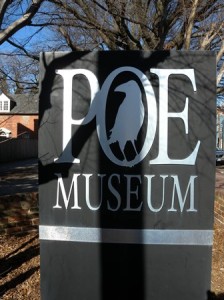 He is further credited with contributing to the science fiction genre, and was the first well-known American writer to try to earn a living through his writing alone. A number of the homes Poe lived in are dedicated museums today; although he never lived in the Old Stone House in Richmond, it houses the Edgar Allen Poe Museum and displays many items Poe used during his time with his foster parents, John and Sarah Allan; it also features several rare first printings of his works. That’s where I went looking, looking, looking for some ghostly lingerings of this brooding man whose life so often focused on death. » read more
He is further credited with contributing to the science fiction genre, and was the first well-known American writer to try to earn a living through his writing alone. A number of the homes Poe lived in are dedicated museums today; although he never lived in the Old Stone House in Richmond, it houses the Edgar Allen Poe Museum and displays many items Poe used during his time with his foster parents, John and Sarah Allan; it also features several rare first printings of his works. That’s where I went looking, looking, looking for some ghostly lingerings of this brooding man whose life so often focused on death. » read more
» posted on Saturday, March 9th, 2013 by Linda Lou Burton
Trailing History
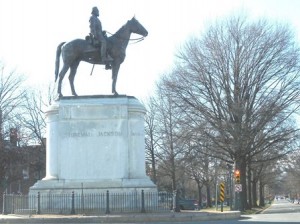 Linda Burton posting from Richmond, Virginia – I need to put my waders on. History is knee-deep here in Richmond, and then some; it is layered and twined with life as it goes on today. Every downtown street and hill top and river bottom is slathered with the taste of it; first-graders on a yellow bus circle Stonewall Jackson’s statue on the way to school. Sunday skateboarders veer down Bank Street, just below the pristine white-columned capitol, first used in 1792, French-inspired, Thomas Jefferson designed. A man walks his red-collared dog in Great Shiplock Park, they stroll the edge of James River on this side of Manchester Docks, where
Linda Burton posting from Richmond, Virginia – I need to put my waders on. History is knee-deep here in Richmond, and then some; it is layered and twined with life as it goes on today. Every downtown street and hill top and river bottom is slathered with the taste of it; first-graders on a yellow bus circle Stonewall Jackson’s statue on the way to school. Sunday skateboarders veer down Bank Street, just below the pristine white-columned capitol, first used in 1792, French-inspired, Thomas Jefferson designed. A man walks his red-collared dog in Great Shiplock Park, they stroll the edge of James River on this side of Manchester Docks, where 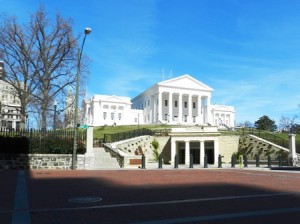 slaves once arrived from Africa. Across the street condo dwellers live in downtown luxury, it’s the reconverted buildings of Tobacco Row where Lucky Strike is bricked into the factory’s chimney, left behind as a historic masterpiece. Suburban dwellers cross Lee Bridge and head home on J D Hway, that’s Robert E Lee and Jefferson Davis, you know; the road is dotted with historic markers directing you to battle sites. Steven Spielberg filmed the movie Lincoln here; no city is more central to the Civil War. But go back farther than that; think John Smith, and Pocahontas, and the Jamestown settlement just downstream. Think
slaves once arrived from Africa. Across the street condo dwellers live in downtown luxury, it’s the reconverted buildings of Tobacco Row where Lucky Strike is bricked into the factory’s chimney, left behind as a historic masterpiece. Suburban dwellers cross Lee Bridge and head home on J D Hway, that’s Robert E Lee and Jefferson Davis, you know; the road is dotted with historic markers directing you to battle sites. Steven Spielberg filmed the movie Lincoln here; no city is more central to the Civil War. But go back farther than that; think John Smith, and Pocahontas, and the Jamestown settlement just downstream. Think  Revolution, and Patrick Henry, whose famous words rang out in St John’s Church on East Broad; “Give me liberty, or give me death.” It’s more than I can wade through in two weeks; I’m dividing the organized trails into groups for exploring, to get at least an overview; early European settlement days; Revolutionary War; and Civil War. Put on your boots and follow me. » read more
Revolution, and Patrick Henry, whose famous words rang out in St John’s Church on East Broad; “Give me liberty, or give me death.” It’s more than I can wade through in two weeks; I’m dividing the organized trails into groups for exploring, to get at least an overview; early European settlement days; Revolutionary War; and Civil War. Put on your boots and follow me. » read more
